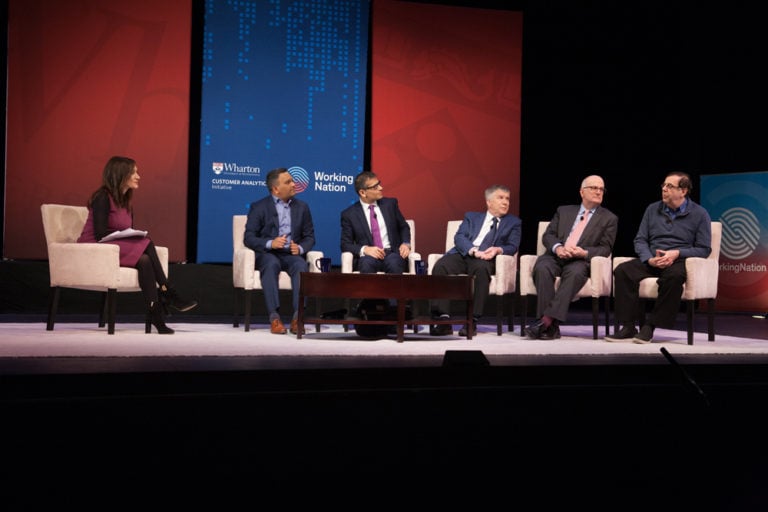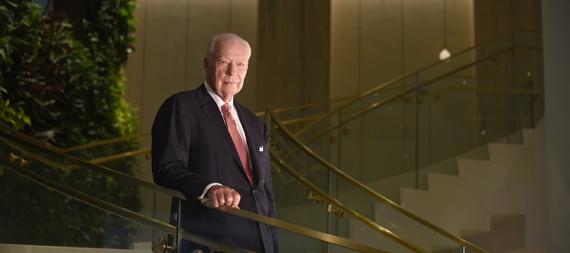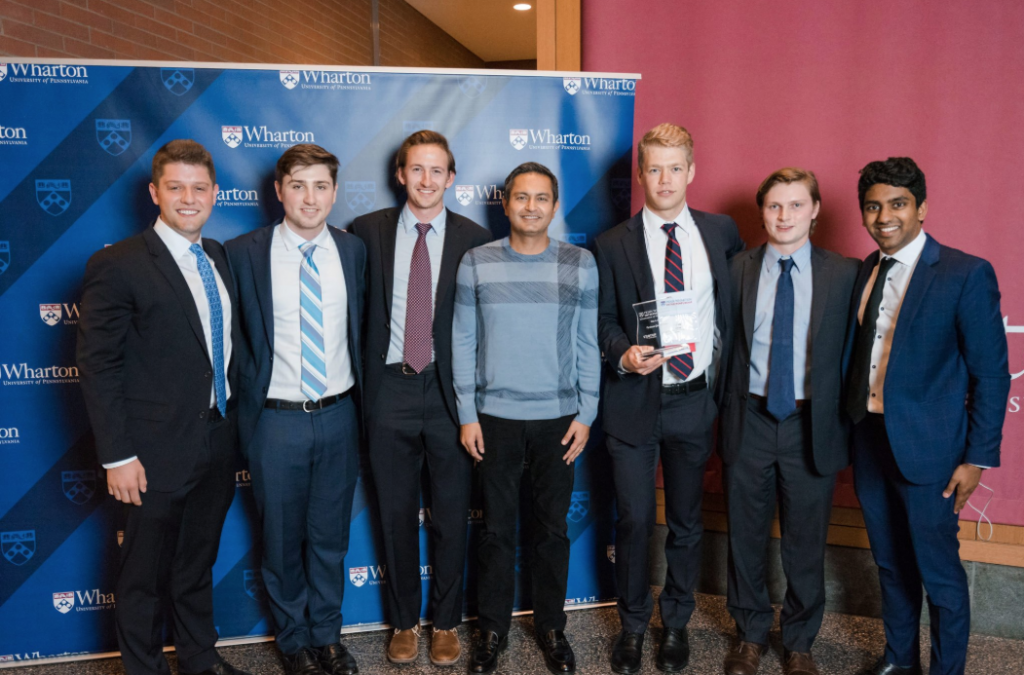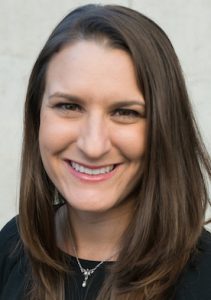Wharton and WorkingNation Discuss Closing the Data Analytics Gap

What’s the next step for employers and educators who want to move the data analytics field forward? That’s the question that top industry leaders and educators discussed during a Wharton School town hall titled, “The Future is Now: Closing the Data Analytics Skills Gap.”
Put together by the Wharton Customer Analytics Initiative (WCAI) and nonprofit WorkingNation, the event kicked off with a keynote address by LinkedIn co-founder Allen Blue. He spoke about why it’s so important to fill the analytics skills gap before handing off the talk to further panelists from Comcast, PwC, the Gates Foundation, Penn Health, Morgan Stanley, and more. In the end, they all came to the same conclusion; data analytics job opportunities will continue to grow, so the need for data analytics skills will increase in proportion.

Panelists on stage (left to right): Ravi Kavikonda, Bhushan Sethi, Steve Kern, Kevin Mahoney (Penn Health) and Tsvi Gal.
The good news is that a valuable data skillset can come from different backgrounds. According to Blue, “Data scientists who came from physics or biology discover and invent new things, whereas somebody who came from a data science program would use a tool they already knew about.” Even history and English majors have the creativity, critical thinking, and high EQ to work in the data analytics field.
However, opening up data analytics positions to a broader range of backgrounds is only the first step. There’s also a need to close the gender gap and to enrich data analytics education, which means building it into core curricula as early as possible. Melanie Harris, the Chief Information Officer of the Philadelphia School District, spoke about the K-8 digital literacy program, and how it’s introducing the gamification of coding by the second grade.
But what needs to be at the forefront of all this change is employers hiring people based on skills over pedigree. According to Jake Schwartz, the Co-Founder and CEO of General Assembly, “I think in the future, we’re going to find really creative ways of putting together talent needs with potential alternative pools of talent, and figuring out how to use education as a bridge to get people [where] they want to be and where the companies really need them.”
Read the full report and watch clips from the panelists here.
This article has been edited and republished with permissions from its original source, Clear Admit.
Penn Wharton Entrepreneurship Startup Challenge Winner Revealed

The 2018-19 Penn Wharton Entrepreneurship Startup Challenge took place on May 3 with 27 teams from across Penn to compete for a chance to win $135,000 in cash and prizes. Eliot Ingram, who has more than 21 years of experience in MBA admissions and is the founder of Clear Admit, headed out to Wharton’s Huntsman’s Hall to experience the event first hand.
Here’s what his experience was like.
Choosing the Finalists
The morning was taken up by 27 semi-finalist teams presenting in front of a panel of judges. From there, the teams were narrowed down to eight finalists who would present in the afternoon. When Ingram arrived at 1:30 p.m., he was just in time to hear the final pitches. Each team was given about six minutes to present and then had about 12 minutes to answer questions from four judges, all of whom had experience as venture capitalists.
Team Presentations
According to Ingram, the teams gave high-quality presentations. Compared to other early-stage investor conferences, Igram felt these teams were competitive, and it was clear Penn Startup venture did a great job coaching each team through the process.
“They each did a great job of conveying the key parts of an investor pitch,” he said. “In addition, the management teams seemed to be a good fit for the business ideas they were presenting. Furthermore, each of the teams did a good job of answering the questions posed by the judges.”
The results were especially impressive given the tight time restriction for each pitch. The teams had to choose what to focus on and make a good argument all in six minutes. Most teams focused on the market size, problem, their solution, and why their team had a competitive advantage rather than financial projection or exit strategies, which must have been a deliberate decision.
The Eight Competitors
- Aerate: Aerate is an innovative air conditioning unit that is 20 times more efficient than current air conditioners. Given the vast market for air conditioning, the rising middle class in India, and the harm that current air conditioners do to the environment, they offered a compelling, scalable tech solution that met a broad market while limiting the environmental impact (team members: Spencer Collins, Jake Fine, Ashwin Kishen, Yann Pfitzer, Conner Sendel, Sam Weintraub).
- Strella Biotech: Strella Biotech offers an innovative and patented way to help fruit packers minimize food waste and maximize produce quality. They do this by using biosensors that measure the ethylene in fruit in order to determine which fruit is ripe and needs to be taken out of the warehouse and sold in the market (team members: Katherine Sizov, Malika Shukurova, Reginald Lamaute, Zuyang Liu).
- Minimize: Minimize is a wearable device that counteracts hand tremors using the same technology that allows buildings to survive earthquakes. It can reduce tremors by up to 95 percent for Essential Tremor and Parkinson Disease patients (team member: Maanav Narula).
- Halo: Halo is a digital monitor attached to taxis or Uber/Lyft cars, which allows advertisers to offer location-enabled digital ads while providing the driver with incremental revenue (team members: Kenan Saleh, Faizan Bhatty, Nabeel Farooqi, Ryanne Fadel).
- Clove: Clove is a shoe design company that creates a shoe customized for health care professionals who spend a lot of time on their feet walking around. Their idea is to build a brand in the health care industry and have brand devotion be the key barrier to entry (team members: Joe Ammon, Jordyn Amoroso, Paula Belatti).
- #PeriodPainFree: #PeriodPainFree offers a women’s health solution based on Chinese herbal medicine and modern technology. It’s a personalized solution to help the 80 percent of women who experience period pains (team members: Lulu Ge, Nicole Glathe).
- Aavrani: Aavrani offers a premium skincare product line inspired by India’s ancient beauty rituals. One of the team members had experience growing a skin care product line from $3 million to $50 million, so they had the expertise needed to deliver clean, non-toxic products. (Team members: Rooshy Roychoudhury, Justin Silver, Nina Davuluri)
- Sigo Insurance: Sigo Insurance offers an auto insurance product tailored for non-traditional or high-risk customers. The company brings the insurance process online to reduce operating costs and remove predatory fees (team members: Nestor Hugo Solari, Julio Erdos).
Long Day
Eight pitches over 2.5 hours is a lot of information over a long time, which was challenging to handle and remain engaged.
“To be honest, while all of the presentations were quite good, after about an hour of listening to three pitches, my mind was getting fatigued with the amount of information being presented,” Ingram remembers. “In fact, I think that the first three teams had a decided advantage in terms of maintaining audience interest, particularly since the first team that presented won first place and the second team that presented won 2nd place.”
The Winners
After all the finalists presented, the judges met for about an hour to decide on the conference winners. During this time, the presenters and the attendees enjoyed booths in the conference hall, a few speeches, as well as a people’s choice voting on the eight finalists. As part of this process, the same eight teams each gave a one-minute elevator pitch in front of the audience.
The winners were:
- Aerate: Grand Prize, Blank Award Winner, Gloeckner Undergraduate Award Winner, & People’s Choice Award Winner
- Strella Biotech: Runner-Up
- Minimize: Innovation Award
- Halo: Launch Award
Overall, Ingram was quite impressed with the high quality of the teams and their presentations.
“There are clearly some talented innovators within the Penn student community,” Ingram says. “In addition, it’s clear that the Penn Start Up Business Plan competition did a good job of helping these teams refine their pitches and getting them ready to meet with investors.”
This Penn entrepreneurship article has been edited and republished with permissions from its original source, Clear Admit.
Where Should You Go? The Benefits of a Mid-Tier MBA

You have an MBA acceptance letter from both Harvard Business School and Cornell SC Johnson. Which do you choose?
Your gut reaction might be to choose Harvard’s top-ranked MBA program without a second’s pause. After all, aren’t business school rankings—like those compiled by the Financial Times and U.S. News & World Report—the most important consideration when choosing your MBA program?
In some cases, you might be right. If you’re most interested in reputation, then ranking is all important. However, there are many times when rankings should be taken with a grain of salt. They tell a story, but not the whole story, especially when it comes to you as an individual candidate.
Just because a specific school is top-ranked, does not mean it should be the top rank for you. Many mid-level MBA programs are just as impressive and could be a better fit for you depending on your needs.
In this article, we’ll take an in-depth look at when and why you should choose a mid-ranked MBA program over a top-ranked program. Continue reading…
Chicago Booth Alumni Gift Funds Marketing Professorship and More

In recognition of the many ways that Chicago Booth has impacted his career, Jim Kilts (Booth MBA ’74) recently make a $4.25 million donation to create the Kilts Family Professorship and the Kilts Faculty Research Prize for Excellence in Marketing. His gift will also go toward providing additional support for the James M. Kilts Center for Marketing. This is just a small piece of the more than $12.5 million that the Chicago Booth alumni has donated to the school’s marketing efforts over the last 20 years.
Through his gifts, Kilts hopes that Chicago Booth will remain on the cutting edge of marketing education. He already believes it’s the best marketing school in the world, and he credits the exceptional faculty, data resources, and multi-disciplined approach with making that possible. Another piece of that success is the Kilts Center, which has a long-standing relationship with Nielsen; this allows them to distribute data sets to more than 1,000 researchers from 130 academic institutions.
According to Jean-Pierre Dubé, Sigmund E. Edelstone Professor of Marketing and Director, Kilts Center for Marketing, “Jim Kilts’ gift to create a new professorship and a new faculty research prize will play an instrumental role in supporting and recognizing ground-breaking research in marketing, while helping us to attract and retain the world’s top marketing scholars.”
About Jim Kilts

Jim Kilts started his career at General Foods when he was just a teenager. By college, he was a lab technician, and that paved the way for his future career. After earning his MBA at Chicago Booth in 1974, Kilts went on to become CEO of three iconic consumer goods companies: Kraft, Nabisco, and Gillette. Later, he founded a financial advisory and private equity firm, and he credits Chicago Booth with much of his success.
“It’s always been a great school and I owe my prosperity to the University of Chicago, the institution which changed my life,” Kilts says. “I hope my latest gift provides the added support to help make Booth the best marketing school in the world.”
Read more about the gift and the Chicago Booth alumni on the Chicago Booth news site.
This article has been edited and republished with permissions from its original source, Clear Admit.
Fighting the Gender Pay Gap at Berkeley Haas

The gender pay gap is still alive and well in business, particularly in tech. At least that’s what Christina Chavez, a ’19 Berkeley Haas MBA student, discovered when she logged into an online compensation board named Blind while working at Microsoft a few years ago. There was a shocking difference between what male and female colleagues were getting paid. So, when Chavez was accepted into the Haas MBA program, she put pay equity and transparency as one of her top goals.
Last fall, Chavez’s goal came to fruition with the help of her classmate Jack Anderson, a fellow member of the Haas Gender Equity Initiative. Together, they set up a spreadsheet where classmates could share details about their compensation packages. Then, using salary data and research provided by Professor Laura Kay, they created a Haas Wage Gap Infographic.
“We earned 96 cents to the dollar in the last MBA class, and people were like ‘yeah we’re approaching equity,’ but this gap grows over time,” Chavez says.
Transparency and the Gender Salary Gap
Unfortunately, for alumni with more than ten years of experience, the salary wage gap between men and women is much more extensive. So, the goal of the project is to expand what’s already offered through CMG Bears (a Haas Career Management Group tool) and to understand the long-term salary gap concern better. Transparency is a critical weapon to close the gap.
And transparency is particularly important when it comes to compensation outside of salary. While recent research conducted by Professor Kray and Margaret Lee at the Center for Equity, Gender, and Leadership (EGAL), revealed that alumni base salaries between 1994 and 2014 were only 8 percent higher for men, it was in the bonuses, share values, and options where men far outpaced women. Overall compensation for Haas women MBAs averages about $290,000—66 percent of men’s $439,000 average.
More than Negotiation Skills
While you might think, at first, that it’s all a matter of negotiation skills, that’s not what Kray and Lee’s research finds. Yes, it’s essential to know what compensation is available and what other people are earning in comparison; the problem for women is that there is an inherent bias toward men. Men tend to be put in charge of larger teams than equally-qualified women, and they get paid more because of it.
“You can change processes, but the long-term problem is people’s individual biases,” Kellie McElhaney, the founding director of EGAL, says. “If they believe things like men do a better job at leading big teams, or that women bosses are unlikable, this is unconscious and conscious bias at work.”
Read the full article in the Haas Newsroom here.
This article has been edited and republished with permissions from its original source, Clear Admit.
GMAT Combinations: Consider The Grouping with the Slot Method

The GMAT loves to present combination questions that force people to sit next to each other, or in certain seats, and then have the test taker figure out how many different ways people not forced to be glued to possibly a very uncomfortable chair can be seated around them. Because free will, clearly, is not an option for many movie-goers, committee members, and/or people seated in a kumbaya circle.
Take this question, for example:
A group of five students bought movie tickets in one row next to each other. If Bob and Lisa are in this group, what is the probability that Bob and Lisa will each sit next to only one of the four other students from the group?
- 5 percent
- 10 percent
- 15 percent
- 20 percent
- 25 percent
See where we are going with this post?
Many test takers will immediately jump to a combination, or potentially a permutation formula (you know, because the order matters), and find themselves completely stuck on what inputs to use. Is it five? Or three? because Bob and Lisa don’t like middle seats?
The reality is that using the slot method–sketching out the seated relationship between these five people–will make it very apparent a). how much easier this problem is to tackle and b). help direct test takers more quickly to the right method of calculation rather than being mired down in trying to figure out if n!/(n-k!) works and what numbers should be used for n and k.
For this question with Bob and Lisa, and similar types of questions, try sketching out as follows:
Bob _____ _____ _____ Lisa
OR
Lisa _____ _____ _____ Bob
It looks like that there are only two different ways that Bob and Lisa can be seated, so then the focus becomes how the remaining three students can be seated. This is accomplished with a very simple factorial–3!–representing the different combinations of the remaining three students.
Alternatively, while a little more time-consuming, considering the combinations of those three movie-goers (who we can name Amy, Belinda, and Carl) is another route that helps us get to the right answer.
ABC
BCA
CAB
BAC
ACB
ACB
Producing six unique combinations. Multiple those six by two–the different seats that Bob and Lisa can be in–and we have 12 different arrangements of student movie-goers. So, 3! = 6 x 2 = 12.
But the issue is that the answer choices are all percentages. By re-evaluating the question, the test taker is being asking to figure out what the probability of this combination will turn out to be. This can be calculated by:
Number of total outcomes where Bob and Lisa only sit next to one person
Total number of possible outcomes
With five students, 5! = 120 is the total number of combinations without restrictions. Placing 12/120 = 10 percent making our answer (B)
When thinking about these types of questions–combinations with restrictions–consider the slot method. Your path to the right answer may be simpler than you think!
This article has been edited and republished with permissions from its original source, Clear Admit.


